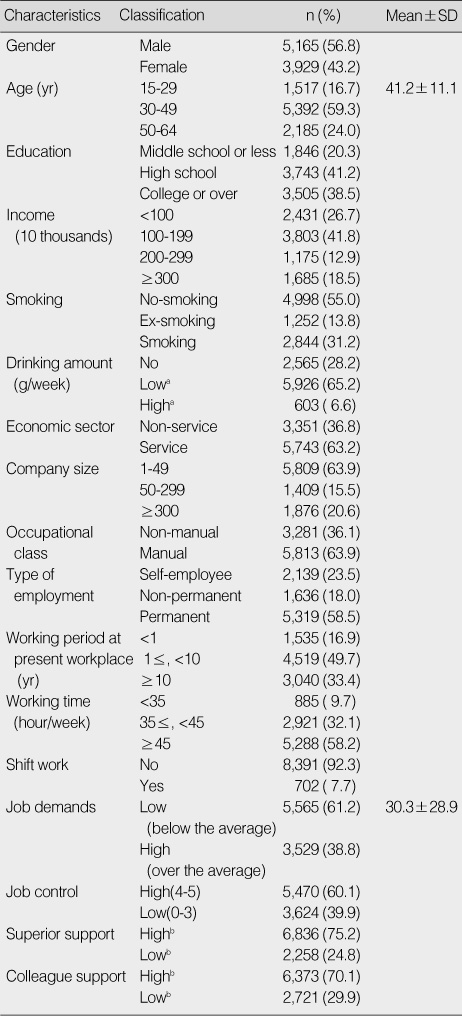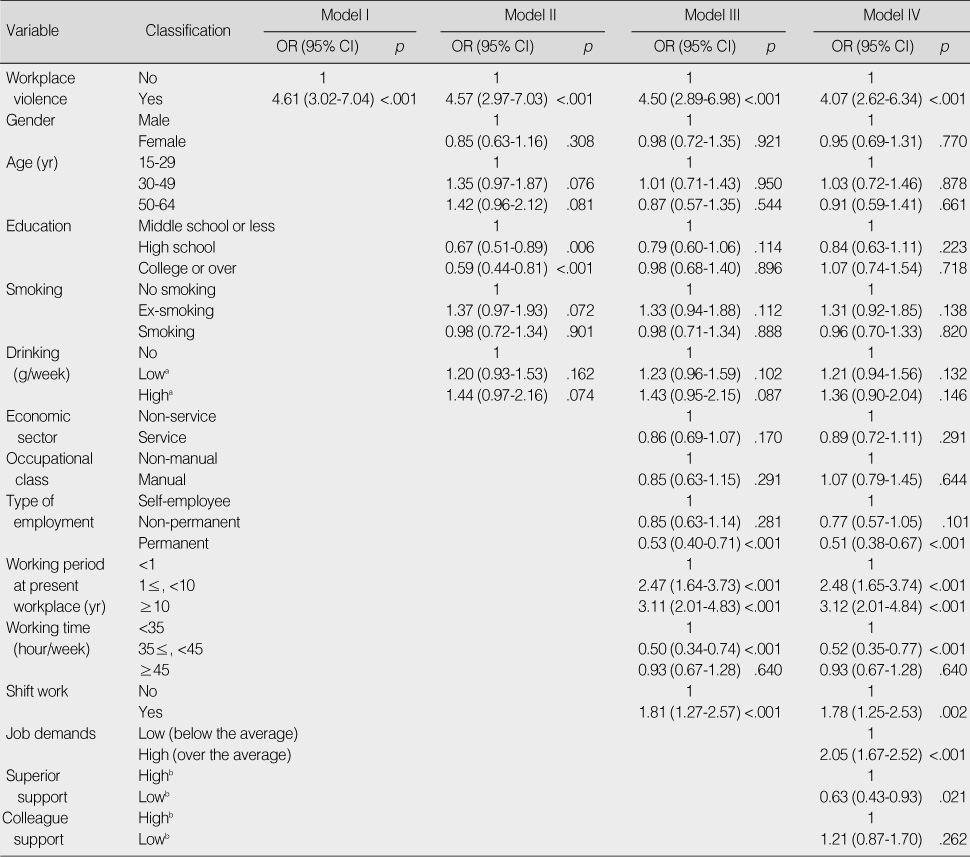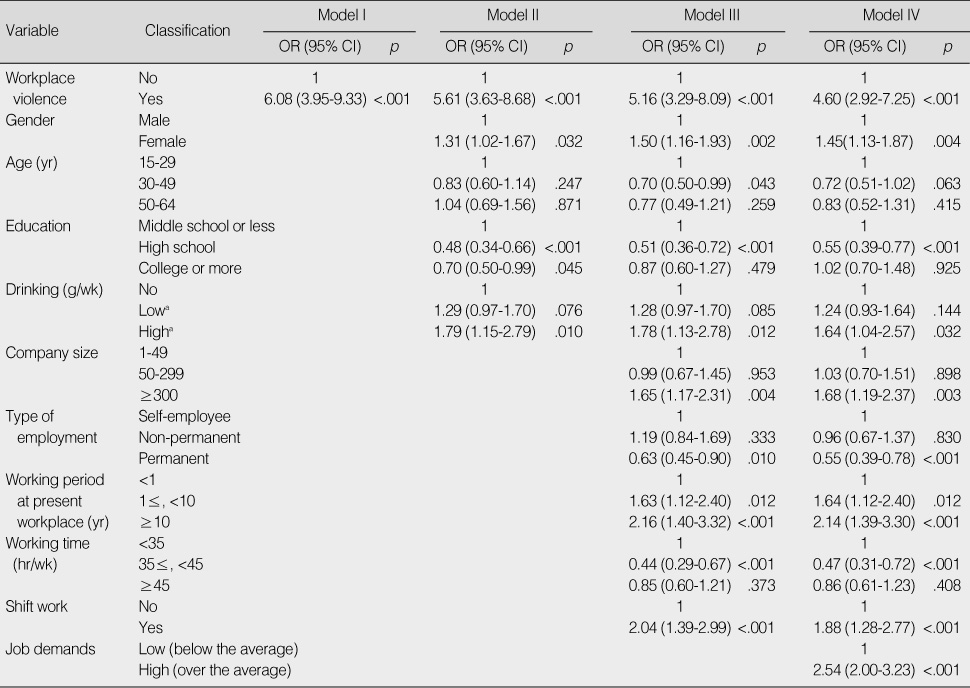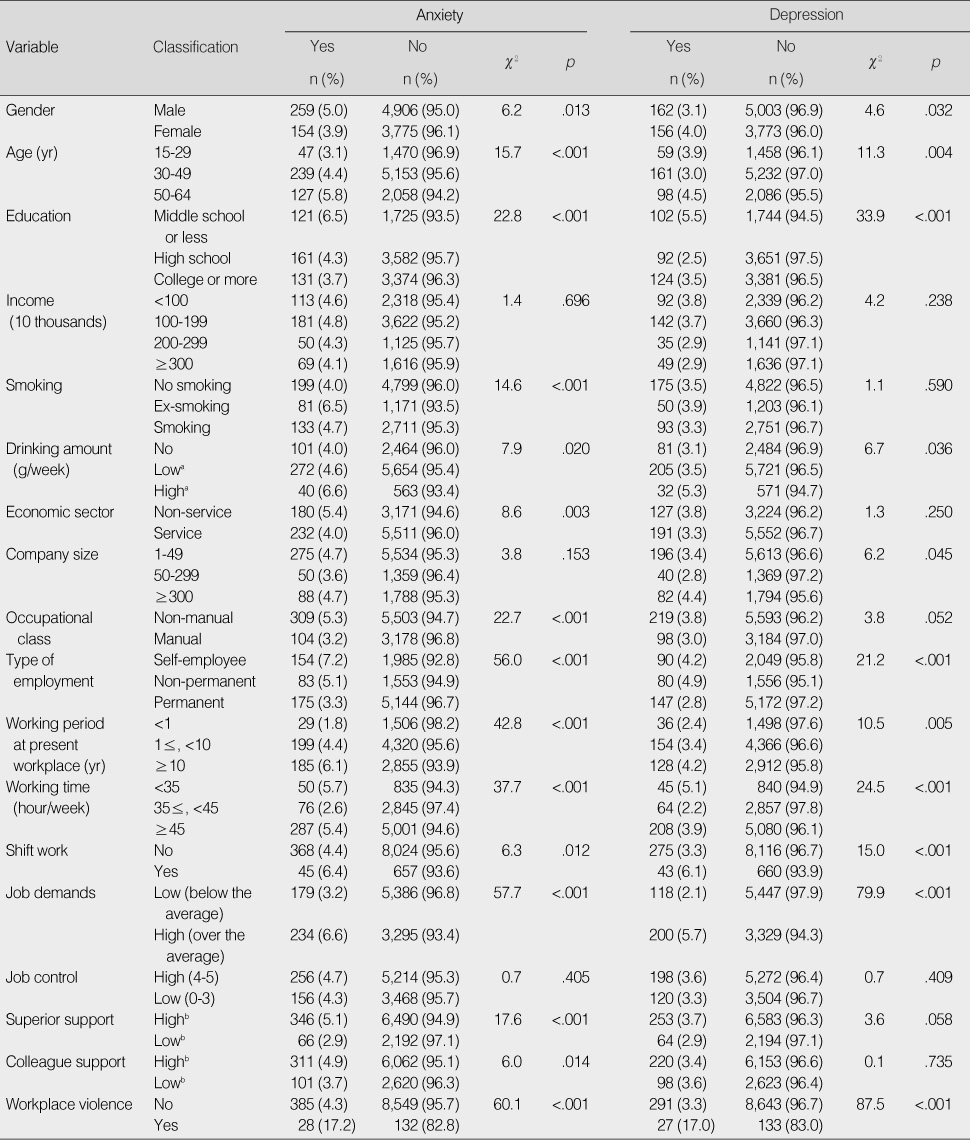Articles
- Page Path
- HOME > J Korean Acad Nurs > Volume 40(5); 2010 > Article
-
Original Article
- The Influence of Workplace Violence on Work-related Anxiety and Depression Experience among Korean Employees
- Eun Sook Choi, Hye-Sun Jung, Su-Hyun Kim, Hyunju Park
-
Journal of Korean Academy of Nursing 2010;40(5):650-661.
DOI: https://doi.org/10.4040/jkan.2010.40.5.650
Published online: October 31, 2010
1Assistant Professor, The Institute of Nursing Science, College of Nursing, Kyungpook National University, Daegu, Korea.
2Assistant Professor, College of Medicine, The Catholic University of Korea, Seoul, Korea.
3Assistant Professor, Department of Nursing, Kyungwon University, Seongnam, Korea.
- Address reprint requests to: Jung, Hye-Sun. Department of Preventive Medicine, College of Medicine, The Catholic University of Korea, 505 Banpo-dong, Seocho-gu, Seoul 137-701, Korea. Tel: 82-2-2258-7368, Fax: 82-2-532-3820, hyesun@catholic.ac.kr
Copyright © 2010 Korean Society of Nursing Science
Abstract
-
Purpose
- Work-related anxiety and depression are frequent work-related mental health problems. In this study the relationship between workplace violence and work-related anxiety and/or depression among Korean employees was evaluated.
-
Methods
- Data were obtained from the Korean Working Condition Survey of 2006. Participants were 9,094 Korean workers aged 15-64 yr. Multiple logistic regression using SAS version 9.1 was used.
-
Results
- The incidence of work-related anxiety, work-related depression and workplace violence were 4.5%, 3.5%, and 1.8% respectively. When personal and occupational risk factors were adjusted, workplace violence was significantly associated with work-related anxiety and depression (OR for anxiety: 4.07, CI: 2.62-6.34; OR for depression: 4.60, CI: 2.92-7.25). Work-related anxiety was significantly related to type of employment, working period at present workplace, work time, shift work, job demand, and social support from superiors. Factors influencing work-related depression were gender, education, alcohol consumption, company size, type of employment, working period at present workplace, work time, shift work, and job demand.
-
Conclusion
- To promote psychological health in workers there is a need to develop work-related anxiety and depression prevention programs and to decrease in workplace violence. In developing these programs, consideration should be given to personal factors, working conditions, and psychosocial working environments.
- 1. Byun CB, Youn K, Jung-Choi K, Cho Y, Paek D. Depressive symptoms of workplace violence exposed subjects in Korea. Korean Journal of Occupational and Environmental Medicine. 2009;21:314–323.ArticlePDF
- 2. Carder M, Turner S, McNamee R, Agius R. Work-related mental ill-health and 'stress' in the UK (2002-05). Occupational Medicine. 2009;1–6. (online published).
- 3. Chang SJ, Koh SB, Kang D, Kim SA, Kang MG, Lee CG. Developing an occupational stress scale for Korean employees. Korean Journal of Occupational and Environmental Medicine. 2005;17:297–317.
- 4. Eriksen W, Tambs K, Knardahl S. Work factors and psychological distresses in nurses' aids: A prospective cohort study. BMC Public Health. 2006;6:290. PubMedPMC
- 5. Han IS, Kim SY, Cho YC. A study on the depression mood among textile industrial workers. Chungnam Medical Journal. 1995;22:33–47.
- 6. Labour Force Survey, Self-Reported Work-Related Ill-Health(SWI). Health and Safty Executive. 2008;Retrieved September 17, 2009. from http://www.hse.gov.uk/statistics/lfs/index.htm.
- 7. Hoel H, Sparks K, Cooper CL. The cost of violence/stress at work and the benefits of a violence/stress-free working environment. 2001;Geneva, International Labour Organization.
- 8. Hong MJ. A study on nurses' experiences of violence. 2009;Daejeon, Eulji University. Unpublished master's thesis.
- 9. Ikeda T, Nakata A, Takahashi M, Hojou M, Haratani T, Nishikido N, et al. Correlates of depressive symptoms among workers in small- and medium-scale manufacturing enterprises in Japan. Journal of Occupational Health. 2009;51:26–37.ArticlePubMedPDF
- 10. Jung HY. A study on relationship among violence experience, coping and burnout of emergency department nurses. 2008;Busan, Inje University. Unpublished master's thesis.
- 11. Kamchuchat C, Chongsuvivatwong V, Oncheunjit S, Yip TW, Sangthong R. Workplace violence directed at nursing staff at a general hospital in Southern Thailand. Journal of Occupational Health. 2008;50:201–207.ArticlePubMedPDF
- 12. Kim JS, Shin KR. A study on depression, stress, and social support in adult women. Journal of Korean Academy of Nursing. 2004;34:352–361.ArticlePubMedPDF
- 13. Kim JY. Drinking, the standardization of data collections and measurements in health statistics. 2000;Seoul, Gyechukmunhwasa.
- 14. Kim SY, Ahn HY, Kim HS. Violence experiences of clinical nurses and nurse aids in hospitals. Korean Journal of Occupational Health Nursing. 2008;17:76–85.
- 15. Kingma M. Workplace violence in the health sector: A problem of epidemic proportion. International Nursing Review. 2001;48:129–230.ArticlePubMed
- 16. 2007 Korean Health Statistics. Ministry of health and welfare & Korea centers for disease control and prevention. 2009;03 19 Retrieved March 31, 2010. from http://knhanes.cdc.go.kr/.
- 17. Korean standard industrial classification. Korea National Statistical Office. 2007a;Retrieved October 10, 2009. from http://www.nso.go.kr/std2006/k07a_0000/k07ab_0000/k07ab_0000.html.
- 18. Korean standard classification of occupations. Korea National Statistical Office. 2007b;Retrieved October 10, 2009. from http://www.nso.go.kr/std2006/data/KSCO_6_1.hwp.
- 19. Lee WH, Kim CJ. The relationship between depression, perceived stress, fatigue and anger in clinical nurses. Journal of Korean Academy of Nursing. 2006;36:925–932.ArticlePubMedPDF
- 20. Morita N, Wada I. Job stress and mental health of child-counseling office workers. Journal of Occupational Health. 2007;49:125–133.ArticlePubMedPDF
- 21. Parent-Thirion A, Fernández Macías E, Hurley J, Vermeylen G. Fourth European working conditions survey. 2007;Retrieved October 20, 2009. from http://www.eurofound.europa.eu/publications/htmlfiles/ef0698.htm.
- 22. Park J, Lee N. First Korean working conditions survey: A comparison between South Korean and EU countries. Industrial Health. 2009;47:50–54.PubMed
- 23. Park JS, Lee GH, Kim JH. Report on Korean working conditions survey in 2006. 2007;Incheon, Occupational Safety and Health Research Institute, Korea Occupational Safety and Health Agency.
- 24. Park KC, Lee KJ, Park JB, Min KB, Lee KW. Association between occupational stress and depression, anxiety and stress symptoms white-collar male workers in an automotive company. Korean Journal of Occupational and Environmental Medicine. 2008;20:215–224.
- 25. Pols RG, Hawks DV. "Is there a safe level of alcohol consumption for men and women" some progress. Drug and Alcohol Review. 1992;11:339–342.ArticlePubMedPDF
- 26. Song YH, GongYoo JO, Kim I, Choi W. The relationship between symptoms, job stress and intensity of labor among security firm workers. Korean Journal of Occupational and Environmental Medicine. 2008;20:283–294.
- 27. Suwazono Y, Okubo Y, Kobayashi E, Kido T, Nogawa K. A follow-up study on the association of working conditions and lifestyles with the development of (perceived) mental symptoms in workers of a telecommunication enterprise. Occupational Medicine. 2003;53:436–442.ArticlePubMed
- 28. US Department of Labor. National census of fatal occupational injuries in 2001. 2002;Washington DC, Author.
- 29. Wang JL, Lesaga A, Schmitz N, Drapeau A. The relationship between work stress and mental disorders in men and women: Findings from a population-based study. Journal of Epidemiology and Community Health. 2008;62:42–47.ArticlePubMed
- 30. Wieclaw J, Agerbo E, Mortensen PB, Burr H, Tuchsen F, Bonde JP. Work related violence and threats and the risk of depression and stress disorder. Journal of Epidemiology and Community Health. 2006;60:771–775.PubMedPMC
- 31. World Health Organization. World report on violence and health. 2002;Geneva, Author.
- 32. Yoo YS, Na C, Lee KH. A correlative analysis between alcohol use and anxious or depressive trends among psychiatric inpatients. Chung-Ang Journal of Medicine. 1990;15(2):97–113.
REFERENCES


aLow alcohol amount (g/week): male (1≤, <280), female (1≤, <140), High alcohol amount (g/week) : male (≥280), female (≥140); bHigh support: get assistance almost always/very often/often, Low support: get assistance sometimes/almost never; Model I Not adjusted; Model II Adjusted for personal factor (gender, age, education, smoking, drinking); Model III Adjusted for personal factor (gender, age, education, smoking, drinking) and working condition (economic factor, occupational class, type of employment, working period, work time, shift work); Model IV Adjusted for all.

aLow alcohol amount(g/week): male (1≤, <280), female (1≤, <140); High alcohol amount(g/week): male (≥280), female (≥140); Model I Not adjusted; Model II Adjusted for personal factor (gender, age, education, drinking); Model III Adjusted for personal factor(gender, age, education, drinking) and working condition (company size, type of employment, working period, work time, shift work); Model IV Adjusted for all.
Figure & Data
REFERENCES
Citations

- Differences in the Effects of Work Environment on Health Problems and Satisfaction of Working Condition by Gender: The 6th Korean Working Conditions Survey
Chae Hyeseon, Park Sooin, Kim Insoo, Ko Myungsun
International Journal of Environmental Research and Public Health.2023; 20(19): 6824. CrossRef - Performance-Based Pay System and Job Stress Related to Depression/Anxiety in Korea: Analysis of Korea Working Condition Survey
Myeong-Hun Lim, Jin-Ha Yoon, Won-Tae Lee, Min-Seok Kim, Seong-Uk Baek, Jong-Uk Won
International Journal of Environmental Research and Public Health.2023; 20(5): 4065. CrossRef - Relationships Between Depressive Symptoms, Interpersonal Sensitivity and Social Support of Employees Before and During the COVID-19 Epidemic: A Cross-lag Study
Songli Mei, Cuicui Meng, Yueyang Hu, Xinmeng Guo, Jianping Lv, Zeying Qin, Leilei Liang, Chuanen Li, Junsong Fei, Ruilin Cao, Yuanchao Hu
Frontiers in Psychology.2022;[Epub] CrossRef - Association between Workplace Violence and Depressive Symptoms among Primary Healthcare Professionals in Shandong, China: Meaning in Life as a Moderator
Meiqi Wang, Haipeng Wang, Zhen Wei, Yifan Wang, Long Sun
International Journal of Environmental Research and Public Health.2022; 19(22): 15184. CrossRef - Mediating Effects of Psychological States on Work Performance of Visiting Nurses According to COVID-19 Workplace Quarantine Measures: A Multi-Group Path Analysis Study
Jee-Hyun Hwang
International Journal of Environmental Research and Public Health.2021; 19(1): 444. CrossRef - Depressive Symptoms Following Work-Related Violence and Threats and the Modifying Effect of Organizational Justice, Social Support, and Safety Perceptions
Lars Peter Sønderbo Andersen, Annie Hogh, Johan Hviid Andersen, Karin Biering
Journal of Interpersonal Violence.2021; 36(15-16): 7110. CrossRef - Does the Type of Exposure to Workplace Violence Matter to Nurses’ Mental Health?
Farinaz Havaei
Healthcare.2021; 9(1): 41. CrossRef - What Are the Experiences of Emotional Labor and Workplace Violence that Are More Harmful to Health in Korean Workforce?
Won Ju Hwang, Hye Kyung Yang, Ji Hye Kim
International Journal of Environmental Research and Public Health.2020; 17(21): 8019. CrossRef - Psychological depletion in physicians and nurses exposed to workplace violence: A cross-sectional study using propensity score analysis
Lei Shi, Guoqiang Li, Jiatong Hao, Weidong Wang, Wei Chen, Shihui Liu, Zhixin Yu, Yu Shi, Yuanshuo Ma, Lihua Fan, Leijing Zhang, Xuanye Han
International Journal of Nursing Studies.2020; 103: 103493. CrossRef - The Relationship between Workplace Violence and Innovative Work Behavior: The Mediating Roles of Employee Wellbeing
Xiang Zhou, Samma Faiz Rasool, Dawei Ma
Healthcare.2020; 8(3): 332. CrossRef - Suppressing emotion and engaging with complaining customers at work related to experience of depression and anxiety symptoms: a nationwide cross-sectional study
Jin-Ha YOON, Mo-Yeol KANG, Dayee JEUNG, Sei-Jin CHANG
INDUSTRIAL HEALTH.2017; 55(3): 265. CrossRef - Influences of Working Conditions and Health Status on Absence due to Sickness in Health and Medical related Workers
Yoonjeong Lee, Hyun-Li Kim
Korean Journal of Occupational Health Nursing.2016; 25(3): 216. CrossRef - Relationship of workplace violence and perpetrators on sleep disturbance-data from the 4th Korean working conditions survey
Taejun Yoo, Byeongjin Ye, Jung-Il Kim, Siwoo Park
Annals of Occupational and Environmental Medicine.2016;[Epub] CrossRef - Effect of Job Insecurity on Job related Depression and Anxiety: Large- and Small-sized Company Employees
Yeongmi Ha, Hyunju Park
Korean Journal of Occupational Health Nursing.2016; 25(4): 329. CrossRef - Relating Factors for Depression in Korean Working Women: Secondary Analysis of the Fifth Korean National Health and Nutrition Examination Survey (KNHANES V)
Kyung-Jae Lee, Jeung-Im Kim
Asian Nursing Research.2015; 9(3): 265. CrossRef - Associations of neighborhood‐level workplace violence with workers’ mental distress problems: a multilevel analysis of Taiwanese employees
Li‐Chung Pien, Duan‐Rung Chen, Chiou‐Jong Chen, Kuei‐Min Liang, Yawen Cheng
Journal of Occupational Health.2015; 57(6): 555. CrossRef - Work‐related Risk Factors for Workplace Violence among Korean Employees
Hye‐Eun Lee, Hyoung‐Ryoul Kim, Jung Sun Park
Journal of Occupational Health.2014; 56(1): 12. CrossRef - The Influence of Workplace Violence on Anger and Post Traumatic Stress Disorder among Nurses
Hyeryeon Yi, Hyun-Sook Moon, Mee-Kyung Shin
Korean Journal of Occupational Health Nursing.2013; 22(3): 240. CrossRef - Health Status and Affecting Factors related to Job among Korean Women Employees
Eun-Young Hong, Sang-Dol Kim
Journal of the Korea Academia-Industrial cooperation Society.2012; 13(9): 4107. CrossRef
The Characteristics of Korean Employees Aged 15-64 Years: Korean Working Conditions Survey 2006 (N=9,094)
aLow alcohol amount(g/week): male (1≤, <280), female (1≤, <140), High alcohol amount(g/week): male (≥280), female (≥140); bHigh support: get assistance almost always/very often/often, Low support: get assistance sometimes/almost never.
Bivariate Analysis of Work-related Anxiety and Depression among Korean Employees
aLow alcohol amount(g/week): male (1≤, <280), female (1≤, <140), High alcohol amount(g/week): male (≥280), female (≥140); bHigh support: get assistance almost always/very often/often; Low support: get assistance sometimes/almost never.
Adjusted Odds Ratios(95% Confidence Intervals) of Work-related Anxiety among Korean Employees
aLow alcohol amount (g/week): male (1≤, <280), female (1≤, <140), High alcohol amount (g/week) : male (≥280), female (≥140); bHigh support: get assistance almost always/very often/often, Low support: get assistance sometimes/almost never; Model I Not adjusted; Model II Adjusted for personal factor (gender, age, education, smoking, drinking); Model III Adjusted for personal factor (gender, age, education, smoking, drinking) and working condition (economic factor, occupational class, type of employment, working period, work time, shift work); Model IV Adjusted for all.
Adjusted Odds Ratios (95% Confidence Intervals) of Work-related Depression among Korean Employees
aLow alcohol amount(g/week): male (1≤, <280), female (1≤, <140); High alcohol amount(g/week): male (≥280), female (≥140); Model I Not adjusted; Model II Adjusted for personal factor (gender, age, education, drinking); Model III Adjusted for personal factor(gender, age, education, drinking) and working condition (company size, type of employment, working period, work time, shift work); Model IV Adjusted for all.
aLow alcohol amount(g/week): male (1≤, <280), female (1≤, <140), High alcohol amount(g/week): male (≥280), female (≥140); bHigh support: get assistance almost always/very often/often, Low support: get assistance sometimes/almost never.
aLow alcohol amount(g/week): male (1≤, <280), female (1≤, <140), High alcohol amount(g/week): male (≥280), female (≥140); bHigh support: get assistance almost always/very often/often; Low support: get assistance sometimes/almost never.
aLow alcohol amount (g/week): male (1≤, <280), female (1≤, <140), High alcohol amount (g/week) : male (≥280), female (≥140); bHigh support: get assistance almost always/very often/often, Low support: get assistance sometimes/almost never; Model I Not adjusted; Model II Adjusted for personal factor (gender, age, education, smoking, drinking); Model III Adjusted for personal factor (gender, age, education, smoking, drinking) and working condition (economic factor, occupational class, type of employment, working period, work time, shift work); Model IV Adjusted for all.
aLow alcohol amount(g/week): male (1≤, <280), female (1≤, <140); High alcohol amount(g/week): male (≥280), female (≥140); Model I Not adjusted; Model II Adjusted for personal factor (gender, age, education, drinking); Model III Adjusted for personal factor(gender, age, education, drinking) and working condition (company size, type of employment, working period, work time, shift work); Model IV Adjusted for all.
 KSNS
KSNS
 E-SUBMISSION
E-SUBMISSION

 Cite
Cite

